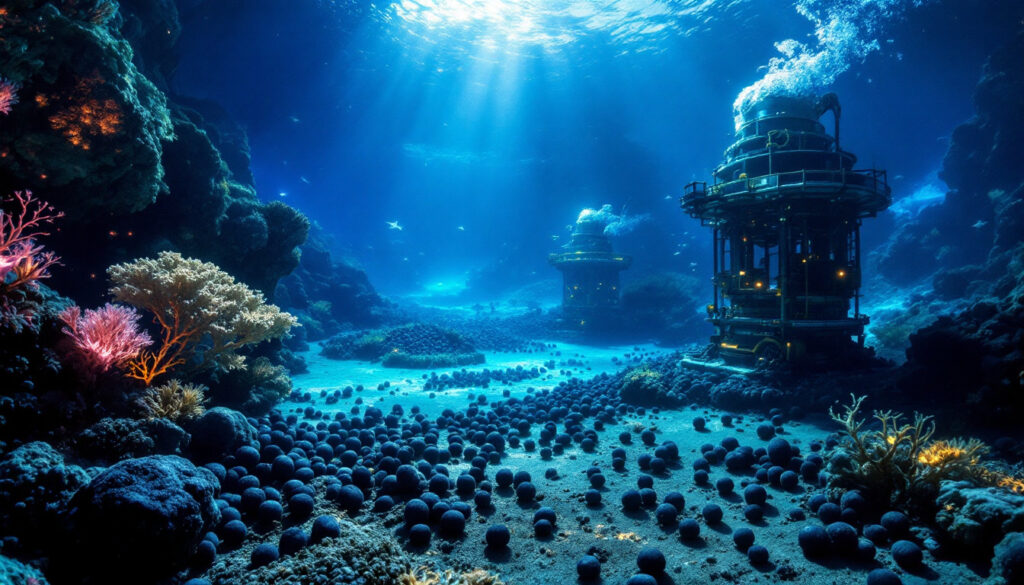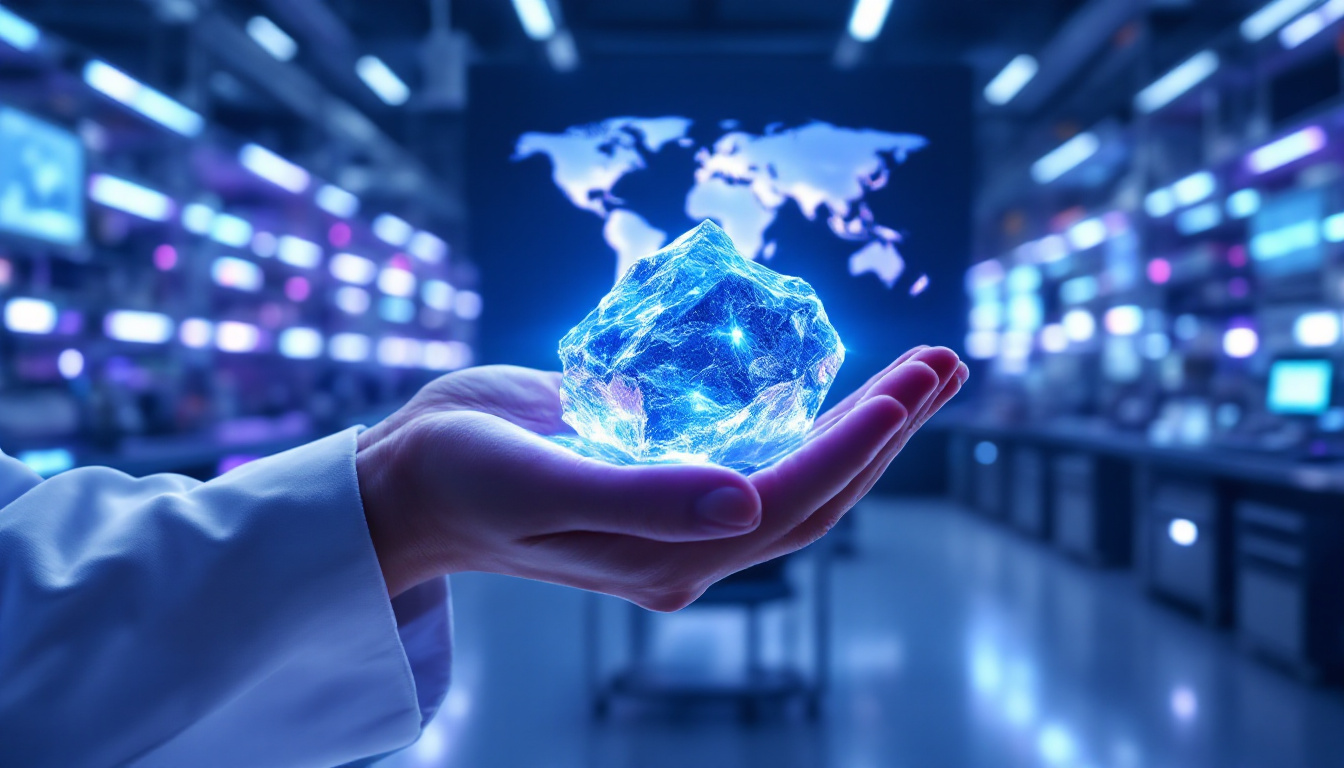What Are Deep Sea Mining Companies?
Deep sea mining companies are specialized entities focused on extracting valuable minerals and metals from the ocean floor. These organizations develop and deploy advanced technologies to harvest resources like polymetallic nodules, cobalt-rich crusts, and seafloor massive sulfides from depths ranging from 1,500 to 6,000 meters below sea level.
At these extreme depths, specialized equipment operates under pressure up to 600 times that at the surface, making operations technically challenging and requiring significant investment in custom engineering solutions. These mining activities are playing an increasingly crucial role in the clean energy transition as demand for critical minerals continues to grow.
Key Types of Deep Sea Mining Operations
- Polymetallic nodule harvesting – Collection of potato-sized rocks containing nickel, copper, cobalt, and manganese, which form over millions of years as minerals precipitate around a core object
- Seafloor massive sulfide extraction – Mining of mineral deposits formed near hydrothermal vents, where superheated water (exceeding 350°C) carrying dissolved metals creates mineral-rich formations when cooling on the seafloor
- Cobalt-rich crust recovery – Gathering of metal-rich layers from underwater mountains and ridges, typically 1-25cm thick and containing some of the highest cobalt concentrations on the planet
Why Is Deep Sea Mining Gaining Momentum in 2025?
The deep sea mining industry is accelerating development due to growing demand for critical minerals needed for renewable energy technologies and electric vehicles. Despite environmental concerns, several factors are driving industry growth.
A single electric vehicle requires roughly 10kg of cobalt, 30kg of nickel, and over 50kg of copper—minerals found in abundance in seafloor deposits. With EV production expected to reach 40 million units annually by 2030, the demand for these metals is projected to increase by 450-600% by 2050. This growing demand is one reason why decarbonisation in mining is becoming increasingly important for the clean energy revolution.
Critical Factors Driving Industry Growth
- Increasing demand for battery metals (cobalt, nickel, copper) for EV production, with cobalt prices surging over 300% since 2016
- Declining ore grades in terrestrial mines, with average copper grades falling from 1.5% to below 0.7% in the past century, making deep sea deposits (with nodules averaging 1.1% copper) increasingly attractive
- Geopolitical concerns about mineral supply chains, with over 70% of cobalt coming from the Democratic Republic of Congo, raising security concerns
- Technological advancements making deep sea operations more feasible, including autonomous underwater vehicles and AI-driven innovations in sustainable mining operations
- Supportive regulatory developments in key jurisdictions like the Cook Islands, which finalized its Seabed Minerals Act in 2019 and awarded exploration licenses in 2022
10. Cobalt Seabed Resources (CSR)
CSR holds promising exploration licenses in the Cook Islands Exclusive Economic Zone (EEZ), an area with exceptionally high-grade polymetallic nodule deposits.
The company’s license areas cover approximately 19,000 km² of seabed with nodule densities ranging from 25-55 kg/m²—significantly higher than the 10-15 kg/m² typical of international waters in the Clarion-Clipperton Zone.
Key Advantages of CSR’s Position
- License location: Operating in the Cook Islands EEZ, which was the first nation to award exploration licenses in February 2022, creating a regulatory head start
- Resource quality: Access to areas with nodule densities exceeding 50 kg/m², containing up to 30% combined metal content by weight
- Local support: Strong government and population backing for deep sea mining activities, with 62% of Cook Islanders supporting responsible resource development in a 2021 survey
- Production timeline: Expected to begin full-scale operations around 2027-2028, with pilot testing scheduled for 2026
9. Impossible Metals
Impossible Metals stands out as the only pure services company on this list, with a revolutionary approach to nodule harvesting that prioritizes environmental protection.
Founded by former SpaceX engineers, the company applies aerospace precision and robotics to develop what they call “keyhole surgery for the ocean floor.”
Impossible Metals’ Innovative Technology
- Selective harvesting: Uses an array of robot “picker” arms guided by computer vision and AI to collect nodules individually without disturbing sediment
- Environmental focus: Designed to significantly reduce sediment disturbance during collection, preserving up to 90% of benthic ecosystems compared to bulk collection methods
- Unique business model: Provides specialized harvesting services rather than holding mining licenses, allowing partnership with multiple license holders
- Technical differentiation: Completely different approach from other nodule collection systems, using swarm robotics rather than traditional bulk harvesting methods
8. Adepth
This Norwegian company combines license holdings with specialized technical solutions for deep sea mining operations.
Adepth has developed proprietary seafloor mapping technologies capable of surveying up to 600km² per day at resolutions down to 0.5m, dramatically reducing the cost of resource assessment.
Adepth’s Strategic Positioning
- Technical expertise: Developed advanced solutions for surveying and data analysis, with AI-driven resource modeling capabilities
- Geographic advantage: Well-positioned for operations in the Norwegian EEZ, which opened for mineral exploration in January 2023
- Service diversification: Able to contract their services to operators in other jurisdictions, creating multiple revenue streams
- Data-driven approach: Focuses on thorough geological mapping and resource assessment, developing digital twins transforming mining efficiency and sustainability
7. Scandinavian Ocean Minerals
Unlike most deep sea mining ventures focused on remote ocean locations, Scandinavian Ocean Minerals is developing resources close to European industrial centers.
The company’s target deposits contain nodules with manganese content exceeding 20% by weight—significantly higher than Pacific Ocean deposits—making them particularly valuable for steel production.
Scandinavian Ocean Minerals’ Unique Approach
- Unconventional location: Targeting polymetallic nodules in the Bothnian Bay and Baltic Sea, in relatively shallow waters of 150-300m depth
- Resource density: Operating in an area covering approximately 200 km² with significant nodule deposits formed through glacial processes rather than typical deep-sea mechanisms
- Regulatory progress: Received exploration permit from the Swedish Ministry of Climate and Enterprise in July 2023, with favorable conditions due to Sweden’s mining-friendly policies
- Strategic advantage: Proximity to European manufacturing reduces supply chain complexity, with processing facilities less than 300km from extraction sites
6. China Ocean Mineral Resources Research and Development Association (COMRA)
COMRA represents China’s strategic investment in securing critical mineral resources from the ocean floor.
As part of China’s 14th Five-Year Plan (2021-2025), COMRA received approximately $2.4 billion in funding for deep sea exploration and technology development, making it one of the best-resourced entities in the sector. According to a recent Statista report, China leads the world in deep sea mining exploration contracts.
COMRA’s Extensive Operations
- Government backing: Strong support from Beijing with substantial financial resources, including a fleet of seven specialized deep-sea research vessels
- License diversity: Holds various subsea mineral licenses in international waters covering over 175,000 km² of seafloor
- Resource types: Active in all three major deep sea mineral categories (nodules, crusts, and sulfides), with particular focus on cobalt-rich crusts
- Geographic spread: License blocks for cobalt-rich crusts in the North Pacific, polymetallic nodules in the Clarion-Clipperton Zone, and seabed massive sulfides in the mid-Indian Ocean ridge
5. Global Sea Mineral Resources (GSR)
GSR brings the expertise and financial backing of a major dredging company to deep sea mining operations.
The company has invested over €150 million in deep sea technology development, including their Patania II nodule collector, which successfully completed seafloor trials in 2021, collecting over 75 tons of nodules.
GSR’s Competitive Advantages
- Corporate backing: Subsidiary of Belgian dredging group DEME, providing substantial resources and expertise in subsea operations
- Prime license areas: Secured high-quality areas in the Clarion-Clipperton Zone containing an estimated 560 million tons of polymetallic nodules
- Technical progress: Ongoing baseline surveying and collector testing with the Patania harvester, designed to minimize sediment disturbance
- Experienced team: Combines scientific expertise with practical offshore operational knowledge, including engineers with over 100 combined years of subsea experience
4. The Metals Company (TMC)
TMC has established itself as the most visible and advanced player in the deep sea mining industry.
The company’s NORI-D license area in the Clarion-Clipperton Zone contains an estimated 356 million tonnes of nodules (wet weight) with average grades of 1.4% nickel, 1.1% copper, and 0.25% cobalt—sufficient to produce batteries for 280 million electric vehicles.
TMC’s Industry Leadership
- Advanced development: Furthest along in testing and regulatory processes, having completed multiple collector tests and environmental studies
- Strong financial position: Well-funded through public listing and partnerships, with approximately $125 million raised in their 2021 SPAC merger
- Technical validation: Reported encouraging results from their NORI-D collector test in 2023, demonstrating 99.5% nodule recovery with minimal sediment disturbance
- Near-term production: Positioned to potentially begin harvesting in the Clarion-Clipperton Zone as early as 2025, pending regulatory approval
- Public awareness: Functions as the industry’s most recognizable representative, with CEO Gerard Barron frequently appearing in media to advocate for deep sea mining
3. Transocean
As a late but powerful entrant to deep sea mining, Transocean brings unparalleled offshore operational experience and resources.
With a market capitalization exceeding $5 billion, Transocean brings financial strength that few competitors can match, enabling rapid scaling once commercial operations begin.
Transocean’s Competitive Strengths
- Operational scale: World’s largest operator of deepwater drilling platforms with 37 mobile offshore drilling units capable of operating at depths up to 12,000 feet
- Strategic partnerships: Formed joint ventures with key industry players, including investment in GSR and technology development with Allseas
- Asset contribution: Providing the Ocean Rig Olympia for conversion to a Production Support Vessel, leveraging existing offshore assets for new applications
- Technical expertise: Extensive experience in complex offshore operations, including subsea robotics and riser systems critical for deep sea mining
- Financial resources: Substantial capital available for deep sea mining ventures, with $4.6 billion in backlog contracts providing stable cash flow
2. Loke Marine Minerals
Loke Marine Minerals has rapidly established itself as a major player through strategic acquisitions and partnerships.
Founded in 2019, Loke has moved aggressively to secure prime license areas and technology partners, establishing itself as Norway’s leading deep sea minerals company. According to Wired’s recent report, Norwegian companies like Loke are at the forefront of industry innovation.
Loke’s Strategic Advantages
- Powerful partnerships: Joint venture with TechnipFMC, Wilhelmsen, and Kongsberg, bringing complementary expertise in subsea operations, logistics, and autonomous systems
- License diversification: Acquired UKSR’s licenses in the Clarion-Clipperton Zone in 2023, adding international water rights to their portfolio
- Geographic flexibility: Positioned for both Norwegian EEZ operations and international waters, reducing regulatory risk through diversification
- Industry backing: Support from established maritime and subsea industry leaders, with combined experience exceeding 200 years in offshore operations
- Resource quality: Access to some of the world’s most promising license areas, including Norwegian sulfide deposits with copper grades exceeding 3%
1. Moana Minerals (OML)
Despite maintaining a low profile, Moana Minerals tops the list due to its exceptional resource quality, experienced leadership, and strategic positioning.
The company holds exclusive rights to 23,000 km² of the Cook Islands EEZ, containing some of the richest nodule fields discovered to date, with average metal content 30-40% higher than CCZ deposits.
Why Moana Minerals Ranks #1
- Premium resources: Holds licenses in the Cook Islands EEZ with average nodule densities of 30 kg/m² (peaking above 50 kg/m²), compared to 10-15 kg/m² typical in international waters
- Expert leadership: Led by Chairman John Halkyard, who worked with the Kennecott Consortium in the 1970s and has practical deep sea mining operational experience spanning five decades
- Diverse expertise: Team combines military, offshore diamond mining, and oil and gas experience, with key personnel from De Beers Marine and Royal Dutch Shell
- Regulatory advantage: Operating in the industry’s most advanced regulatory regime, with full exploration permitting in place since 2022
- Production potential: Developing what may be the highest-quality resource in the entire industry, with nodules containing up to 31% combined metal content by weight
How Are These Companies Approaching Environmental Concerns?
Deep sea mining faces significant environmental scrutiny, with companies adopting various approaches to address ecological impacts.
Recent baseline studies in the CCZ have documented over 5,000 species, with approximately 90% previously unknown to science, highlighting the biodiversity at stake and informing mitigation strategies.
Environmental Mitigation Strategies
- Selective harvesting: Companies like Impossible Metals developing technologies to minimize sediment disturbance, preserving up to 90% of benthic habitats compared to bulk collection
- Baseline studies: Extensive environmental monitoring before, during, and after operations, with TMC alone collecting over 250,000 biological samples across multiple expeditions
- Regulatory compliance: Working within frameworks established by the International Seabed Authority and national governments, including environmental impact assessments and monitoring protocols
- Technological innovation: Developing equipment designed to reduce ecosystem disruption, such as sediment curtains, filtered return systems, and targeted collection methods
- Transparency: Publishing environmental impact assessments and test results, with several companies establishing independent scientific advisory boards
What Technologies Are Being Developed for Deep Sea Mining?
The success of deep sea mining operations depends on specialized equipment designed to operate at extreme depths under enormous pressure.
Current nodule collector systems process approximately 100-200 tons of nodules per hour, with next-generation systems targeting 400-600 tons per hour while reducing environmental impacts. This technological advancement will be key to the mining industry’s future as predicted for 2025 and beyond.
Key Technological Developments
- Harvesting systems: Specialized collectors like TMC’s nodule collector and Impossible Metals’ robotic pickers, using various approaches from vacuum systems to selective robotic arms
- Production support vessels: Converted or purpose-built ships like Transocean’s Ocean Rig Olympia, capable of processing 3,000-6,000 tons of nodules daily
- Riser systems: Technologies to transport minerals from seafloor to surface, including airlift systems that can move material over 4,000 meters vertically
- Separation systems: Methods to separate nodules from sediment with minimal environmental impact, including vibrating screens and hydraulic classifiers
- Monitoring equipment: Advanced sensors and autonomous vehicles for environmental assessment, including DNA sampling, water chemistry analysis, and sediment plume tracking
FAQs About Deep Sea Mining Companies
What minerals are deep sea mining companies targeting?
Deep sea mining companies primarily target four metals found in polymetallic nodules: nickel, copper, cobalt, and manganese. These metals are essential for renewable energy technologies, particularly batteries for electric vehicles. Some operations also target rare earth elements, zinc, gold, and silver found in seafloor massive sulfides and cobalt-rich crusts.
A typical high-grade nodule contains 1.2-1.5% nickel, 1.0-1.3% copper, 0.2-0.25% cobalt, and 27-30% manganese
Interested in Discovering the Next Major Mining Opportunity?
Stay ahead of the market with Discovery Alert’s proprietary Discovery IQ model, delivering instant notifications on significant ASX mineral discoveries across 30+ commodities. Explore how historic discoveries have generated substantial returns by visiting our dedicated discoveries page and begin your 30-day free trial today.




